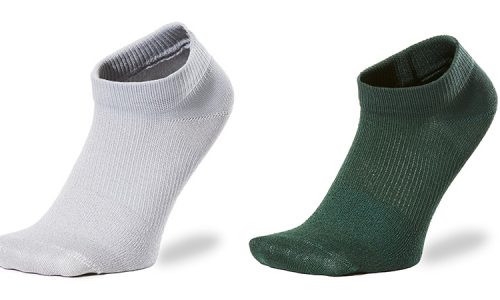How does the Gear Institute test a running shoe’s “stability”?
Our stability rating tells you how much pronation and supination occurs when a running shoe impacts the pavement and roles throughout the stride. The higher the rating you see, the more stable the shoe is.
To measure how inherently stable a shoe is, our colleagues at Heeluxe, Gear Institute’s running shoe laboratory partner, measure each shoe’s “peak pronation force.” This is the maximum amount of inward “roll” that the shoe allows—measured at the instant where the arch has reached its lowest point. In most shoes, this occurs in mid to late stance, right before propulsion. Heeluxe also measures “peak re-supination” which occurs in late stance as the arch increases its height and the foot becomes more rigid. Finally, Heeluxe measures the “average sway” during the entire stance. These three measurements combine to create the stability measurement.
To capture this data, Heeluxe examines two sets of data, one for runners logging a 6-minute-per-mile pace, and another for runners logging an 8-minute-per-mile pace. Utilizing measurements at multiple paces allows the stability score to relate to the largest number of runners possible.
What do you mean by “stability”?
Some pronation is a good—it’s your body’s natural shock absorption mechanism. But you can have too much of a good thing. Basically, the taller and softer a shoe is, and the narrower its base, the less stable it will be underfoot, and the more your body will have to work to compensate for that instability.
Certain shoes cause your foot to pronate more than it naturally would have if you were running barefoot. That extra rolling causes fatigue, as your body has to fight to over correct your foot as it rolls too fast or too far over your arch. (Some runners prefer a less stable shoe, either because they are strong enough to control their foot in these shoes or they are interested in strengthening their stabilizing muscles.) On the other hand, a shoe that is inherently stable will decrease the amount of “overpronation” and encourage “re-supination” in each stride, which lowers the strain on the stabilizing muscles (especially for faster or heavier runners), and reduces the susceptibility to injury of newer runners. In short, you want a shoe that does not increase your pronation at all—allowing your foot to do all the pronating it needs too, without the shoe making it do any more.
What we are not testing is how much “pronation control” a running shoe offers. Pronation control refers to the structural elements a shoe uses to combat the foot’s natural tendency to pronate. The more stability structures a shoe has, like medial posting and arch braces, the less rolling your foot will do. We don’t rate that. What we are testing is how stable the shoe itself is, irrespective of whether you are a pronator, supinator, or neutral runner.
The Gear Institute is the only running shoe media outlet that tests stability (as opposed to mere “flexibility”) in an objective manner.
How does the Gear Institute test a running shoe’s “durability”?
For our durability test, we look at how much wear and tear the shoe undergoes after 150 miles of testing. We focus on three things: outsole and upper wear, collapse of the ramp angle, and breakdown of the shoe’s cushioning power.
The simplest test we conduct is for outsole and upper wear. After 150 miles of have been logged on the shoe, we inspect the shoe for visible wear and tear and then rate what we see. Some shoes show significant amounts of rear to the rubber or foam outsoles, while some show barely any abrasion. The uppers may be look new, or might have tears, stitches coming loose or welds coming undone. Of the 10 points allotted to our Durability rating, a maximum of four points comes from this visual inspection.
We also conduct a test that measures how much the shoe’s ramp angle changes over the course of 150 miles. For example, while you may purchase a shoe with a 6-mm heel-to-toe drop (aka, ramp angle, offset), that angle can change—sometimes up to +/- 8-mm—as the shoe’s midsole begins to compress at different rates in the forefoot and heel.
To do this, our lab partner, Heeluxe, analyzes the ramp angle when the shoe is brand new (and being weighted by a tester), and then measures it again under the weight of the same tester after 150 miles of road use. The more the ramp angle changes, the lower the score the shoe will receive for Durability. Of the 10 points allotted to our overall Durability rating, a maximum of three points comes from this measurement.
In our final test, we analyze the shoe how much the cushioning of each shoe has broken down over the course of 150 miles. As a shoe’s midsole foam breaks down, its cushioning properties are compromised, and the shoe will grow firmer. Our laboratory partner, Heeluxe, performs about two dozen pressure scans of each shoe when the shoe is new, and again after 150 miles of road wear, to determine how the cushioning profile of a shoe changes over the course of all that pounding.
The data from these foot scans can tell us objectively exactly how much cushioning has been lost. (You can see the changes visually in our published footscans as low-pressure blue areas have collapsed into higher-pressure red areas). The more change we see, the lower a shoe will score. Of the 10 points allotted to our overall Durability rating, a maximum of three points comes from this cushioning breakdown measurement.
The Gear Institute is the only running shoe review outlet that provides such objective measurements of running shoe breakdown.
How does the Gear Institute determine how soft or how firm a shoe is?
To objectively determine how soft or firm a shoe is, we don’t just rely on our wear test team. Our colleagues at Heeluxe, the Gear Institute’s partner for running shoe test lab testing, take two-dozen pressure scans of each shoe. Based on the data from those scans, we rate the forefoot and heel softness of each shoe on a scale of one to five, with one being “soft,” and five being “firm.”
How does the Gear Institute test “heel drop”?
The Gear Institute has partnered with Heeluxe to objectively measure a shoe’s heel drop, and we do so in a way that no other running shoe review media can. (Click here to learn more about heel drop).
First, before the shoe has been worn, Heeluxe measures the stack heights of shoes—the actual height between the ground and the top of the insole—in the heel and forefoot. The measurement is accurate to within 0.5 mm. The difference between the forefoot height and heel height is what we call “0-mile unweighted heel drop.”
Next, the same measurement is conducted with a 170-pound male tester (or a 120-pound female tester) standing in the shoes. This shows what we call “0-mile weighted heel drop”—or which Heeluxe refers to as “Real Drop”(TM). This is the most accurate and most honest way of measuring heel drop, since it’s the ramp angle that your foot actually experiences when you are wearing the shoe fresh out of the box.
The same weighted measurement is taken after 150 miles to determine how much the ramp angle has changed as the midsole collapses over time. When the heel collapses faster than the forefoot, for example, the ramp angle will change—so that a 12-mm drop shoe may become a 6-mm drop shoe, or a 2-mm drop shoe can actually become a minus 2-mm drop shoe. We call this rating the “150-mile weighted heel drop.”













